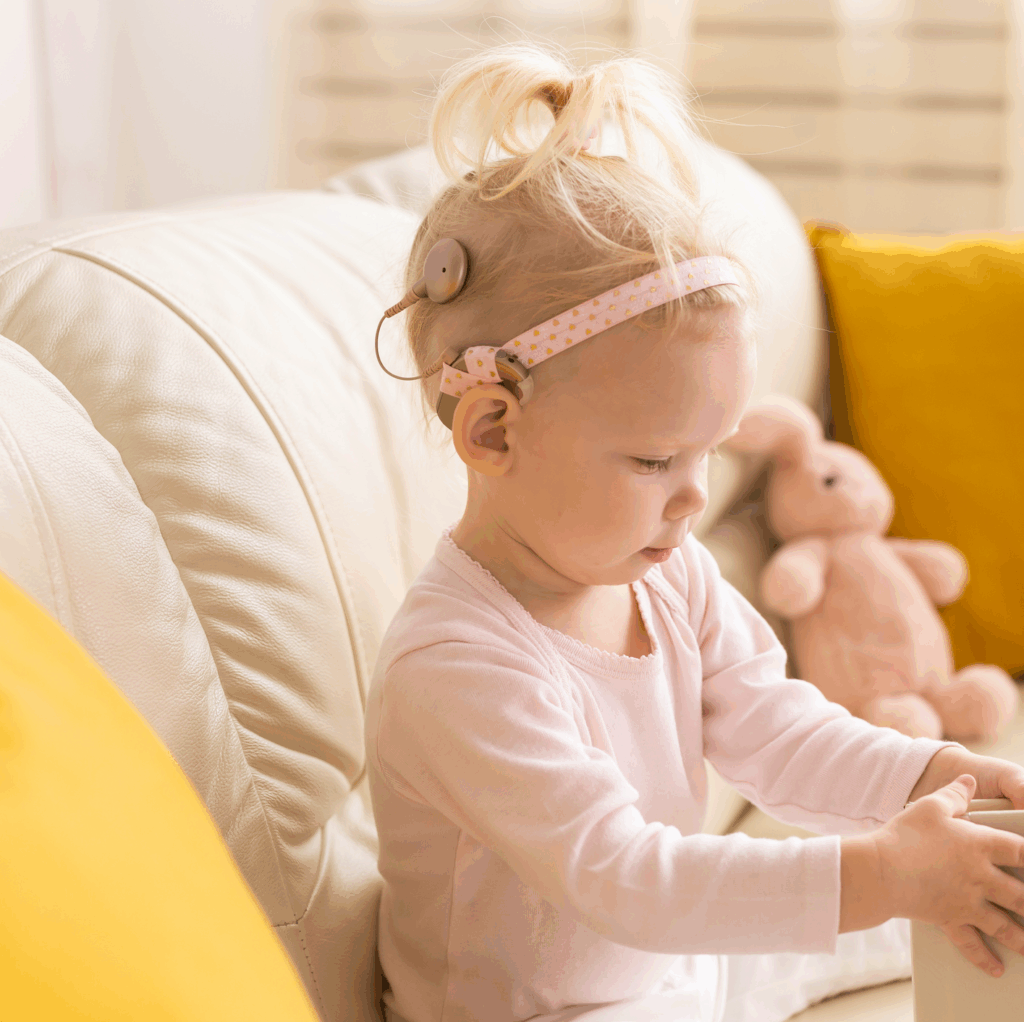In the second part of our series on congenital cytomegalovirus (CMV), we speak with two Nemours associates and mothers of children diagnosed with CMV at different stages of their journeys. They share personal stories of diagnosis, advocacy, resilience, and the everyday realities of parenting children affected by CMV.
Nemours Children’s Health policy experts also join the conversation to discuss current efforts and ongoing needs at the state and federal levels, including raising awareness, improving screening and supporting families through initiatives like the STOP CMV Act and other legislative efforts.
Featuring:
Daniella Gratale, MA, Associate Vice President, Federal Affairs, Nemours Children’s Health
Casey Osgood Landry, MPH, Senior Advisor, Legislative & Regulatory Affairs, Nemours Children’s Health
Caroline Bruce, MS, RD, LDN, CDCES, NASM-CPT, mom of child with CMV, Wellness Program Manager and Peer Support Program Manager, Nemours Children’s Health
Brittany Fitts, RN, mom of child with CMV, Senior Data Analyst, Nemours Children’s Health
Host/Producer: Carol Vassar
Announcer:
Welcome to Well Beyond Medicine, the world’s top-ranked children’s health podcast produced by Nemours Children’s Health. Subscribe on any platform at NemoursWellBeyond.org or find us on YouTube.
Carol Vassar, podcast host/producer:
Each week, we’ll be joined by innovators and experts from around the world, exploring anything and everything related to the 85% of child health impacts that occur outside the doctor’s office. I’m your host, Carol Vassar, and now that you are here, let’s go.
MUSIC:
Let’s go, oh, oh, well beyond medicine.
Carol Vassar, podcast host/producer:
You’re listening to part two of a two-part series on cytomegalovirus or CMV. Specifically, congenital CMV, which is contracted in utero. If you missed part one, that episode covers the medical aspects of congenital CMV and the effects it can have on children exposed to this common virus in their mother’s wombs. We’ve put a link to that episode in the show notes.
Briefly, though, CMV is a pretty common virus. Most of us have had it, we’ve been exposed to it by about the age of 20, but not everyone. And pregnant moms need to take extra precautions to prevent passing it on to their babies. And the effects, well, congenital CMV is the leading non-hereditary cause of hearing loss in children. Knowing about congenital CMV and taking action to prevent it when a woman is pregnant are key. For example, paying special attention to hand hygiene regimens. Yet despite its prevalence and the long-term consequences, congenital CMV has a pretty low profile among women of reproductive age and many healthcare professionals. We’ll talk a little bit later in this episode about how policy levers are being brought to bear with regard to congenital CMV. But joining me right now are two women looking to help raise awareness of this issue by sharing their stories of how a congenital CMV diagnosis for their child has affected them personally.
Caroline Bruce is a registered dietitian and manager for the wellness and peer support programs at Nemours Children’s Health, and the mother of a two-and-a-half-year-old Violet. Brittany Fitts is also here; she’s a nurse who has worked in the intensive care units at Nemours and now serves as a senior data analyst for the organization. She is the mother of 7-year-old Hadley. Both of these children have been diagnosed with congenital CMV, but at different points in their journey, a journey where early intervention is vital. Brittany and Hadley, for example, had that early intervention based on one of the most unscientific yet powerful tools in a mother’s toolbox, her intuition. Here’s Brittany Fitts.
Brittany Fitts, Nemours Children’s Health:
Early on in my pregnancy, I was working as a pediatric intensive care nurse at Nemours, and I had asked my OB to send the TORCH screening, which includes CMV, early on in my pregnancy. To this day, I can’t really explain why I asked for that. I had no exposures or I wasn’t sick or anything like that, but just the desire to check all the boxes and make sure that everything was going well. I’ll never forget coming into the office and the OB even asking, “Why did you want us to send those labs again?” And being like, “Well, it’s positive,” and kind of the fear that then spiraled into. Fast-forward to my delivery, Hadley was born, it was pretty uncomplicated delivery, but then the day later, she failed her newborn screening. And even with that, it took a lot of advocating to even have Hadley tested for CMV, which we eventually did, and it came back positive, and as a result, she has left profound hearing loss with a cochlear implant.
Carol Vassar, podcast host/producer:
And you being in the healthcare field, it might’ve given you a little bit of an advantage to know that this could be an issue, especially working with children. Do you think that’s a fair statement?
Brittany Fitts, Nemours Children’s Health:
Yeah, I definitely think that’s accurate. Even just telling my story to my friends or turning to them for support, many of them didn’t even know what CMV was or had ever heard of it. And obviously, this is things that I had seen in the ICU, so at least was aware of the diagnosis and what the effects could be.
Carol Vassar, podcast host/producer:
Caroline is nodding her head, but her situation with her daughter, Violet, was different. Caroline, tell us about that.
Caroline Bruce, Nemours Children’s Health:
Yes, so my experience with congenital CMV with my daughter Violet was very different. I had not heard of CMV when I was pregnant, and I educated myself when I was in my pregnancies. I listened to audiobooks, listened to podcasts, had two baby apps on my phone. I was very up-to-date with the things that I needed to do to keep myself and my baby healthy. I heard 50 million times not to empty the litter in my cat’s litter box, but I didn’t hear about CMV and the things that I could have done to protect myself and my child while I was pregnant.
So my daughter, Violet, did not get diagnosed with congenital CMV until she was about two. And our journey started when she was about four months old. We noticed that she was missing milestones for reaching for and holding objects. So I had a conversation with her pediatrician about it, we gave her a little more time to see if she would catch up, and she didn’t. So we ended up enrolling her in an awesome program we have in Delaware called the Birth to Three Program, where she received in-home physical therapy once a week. But after about nine months to a year of that physical therapy, we saw that she was making progress, but lower than we would want. So it prompted us to start exploring, okay, what’s going on here? This is something that needs more than just once-a-week physical therapy, and I really started to grow concerned that there was more going on than just a little bit of a delay.
So, fast-forward through a few wrong rabbit holes that we went down and trying to figure out what was going on, Violet had a sedated brain MRI when she was around two, which showed brain damage consistent with congenital CMV.
Carol Vassar, podcast host/producer:
And she’s not your first child, and you’d never heard of CMV through either pregnancy, did you?
Caroline Bruce, Nemours Children’s Health:
No. Yes, she is my second child. I have a beautiful four and a half year old daughter, and I have Violet, my two and a half year old. And many pregnant women contract CMV because of their children. Because I am the mom, like I said, who completely educated myself when I was pregnant, but I’m also the mom who if my at the time, one and a half year old wants me to take a lick of her lollipop or drink after her, or one and a half year olds run up to you on the playground and wipe their noses on you and things like that, all of those things could have put me at risk for contracting CMV. So yes, I had another child, had not heard of it in any of my pregnancies, but many pregnant women end up contracting the virus from their child.
Carol Vassar, podcast host/producer:
Caroline, what was surprising or difficult for you to learn about CMV after Violet was diagnosed?
Caroline Bruce, Nemours Children’s Health:
The hardest thing for me is just how common it is. I get emotional every time I talk about Violet, but one in 200 kids, according to the CDC, is born with congenital CMV, and 20% of the time they will have some kind of adverse health effect as a result of it. Those are big numbers. This is not an uncommon virus, but the fact that I had never heard of it boggles my mind. Or the fact that, like Brittany said, you talk to friends and family about it, and they’ve never heard of this virus that’s very common, and that was very surprising to me.
Carol Vassar, podcast host/producer:
Same question, Brittany. What was surprising or difficult to learn after you were diagnosed with CMV, and your daughter was?
Brittany Fitts, Nemours Children’s Health:
I think the hardest thing for me was that there was no defined definition of what it could look like. There’s such a wide spectrum, and you can see that between Violet and Hadley. Hadley has hearing loss, Violet has cerebral palsy, and there’s just no way to know what the outcomes would be. And so, early on when I had found out, it was really that fear of the unknown and not knowing what our life could look like.
Carol Vassar, podcast host/producer:
So, what does your life look like today, Brittany? How has CMV affected the daily life?
Brittany Fitts, Nemours Children’s Health:
So Hadley is an active, very smart seven-year-old little girl. At this point, I’ll be honest, it’s not something that is constantly on my mind. She’s had her cochlear implant now for five years, she’s very independent with it, and I’m so thankful for the journey that we’ve been through. I truly believe that me asking for that test allowed me to really advocate for her early on, get physical therapy, speech therapy, and all of the necessary interventions early, so that we could be where we are today.
Carol Vassar, podcast host/producer:
Caroline, same question. There are challenges that come with this. There are strengths you’ve probably discovered along the way. Talk about how your family unit is doing today.
Caroline Bruce, Nemours Children’s Health:
So our days are filled with a tremendous amount of joy, but we do have some challenges. Anyone who has had young children knows that there are certain milestones that your children reach that mean that your day-to-day life looks a little bit easier. Like when your child can brush their teeth on their own, when they can feed themselves, when they can go to the bathroom by themselves, when they can get themselves dressed. All of those things make getting out the door just a little bit easier.
And Violet at two and a half is nonverbal, she can’t sit independently, she can’t walk, she can’t crawl. Girlfriend gets where she wants to go. She just started army crawling recently, and she rolled, so she does have a way of getting from A to B, but we have to feed her still. Violet is at an increased risk of choking; she gags a lot, so at two and a half, she’s still on a lot of pureed foods and yogurt, so I can’t sit her down in her chair and have her feed herself soft salads while I’m packing my preschooler’s lunch. She does not have independence, so there are a lot of things that we need to do for her.
We don’t let the cerebral palsy or congenital CMV limit us in what we want to do as a family. We’re very blessed to live in a time where the world has to open up and make space for Violet. So all of the community events and places that we’ve gone, we haven’t had challenges with access or anything like that. So we’re very lucky to still be able to do all the things that we want to do. But a large part of that, too, is the fact that Violet’s very petite; she weighs about 22 pounds. So if we want to do anything with her, we throw her. We can pick her up and take her wherever we want to go. I imagine that as she gets older, as she gets bigger, that could look different, and our day-to-day life could be more challenging just as she starts to get bigger.
Carol Vassar, podcast host/producer:
You’re not only moms, but you’re also Nemours associates. You’re working moms, you’re wearing both the hats: mom and associate. How has that changed the way that you look at CMV and the kind of support you need and that families need in general? Caroline?
Caroline Bruce, Nemours Children’s Health:
So, I’ll say that there are beautiful, magical things that happen within the walls of Nemours Children’s Health, but there are also very sad things that I see and that I hear about. And while we have our challenges with Violet, Violet will have her challenges in life; it does make me extraordinarily grateful and provides perspective to know that Violet can live a long, healthy, fulfilling life with congenital CMV, unlike some of the kiddos that I know come into our organization. So, it’s given me a very different perspective.
Carol Vassar, podcast host/producer:
Brittany, same question. As an associate, as a mom, what kind of perspective, what kind of support do you feel you need or families like yours need?
Brittany Fitts, Nemours Children’s Health:
Yeah, I would echo what Caroline is saying. As a nurse in the intensive care units, I’ve been with families at some of the worst moments of their child’s health journey. So, to be able to advocate for your child and really understand what’s available within Nemours, I think, is so valuable and is really why I am part of this team and just advocating for early awareness.
Carol Vassar, podcast host/producer:
Open question for either of you. Do you feel as though CMV needs a higher profile, especially amongst pregnant women? Caroline.
Caroline Bruce, Nemours Children’s Health:
Absolutely, I do, yes. I think that there needs to be more awareness of what CMV is, the risks that it poses, and the things that you can do to prevent it. I don’t think it’s enough to tell pregnant women to make sure that they’re consistent with their hand hygiene. Tell them why and tell them all the things that could happen with CMV. And there are other reasons, of course, to be very consistent with hand hygiene and the things that you can do to prevent CMV, but if pregnant women knew how prevalent this virus is and the major adverse effects that it can cause, I think that they should know that.
Carol Vassar, podcast host/producer:
Brittany, tell us what you would like other patients, other parents, other clinicians to know right now, especially if they know or are themselves pregnant.
Brittany Fitts, Nemours Children’s Health:
Yeah, I think prevention is key. I have had two children since Hadley, and I can say that it was never mentioned after that. And now I was then aware and really listening, and no one ever said anything about CMV. And Hadley is now seven years old, so I was like, oh, it’s maybe dated, but my youngest will be a year this year, and it’s still not being mentioned during your pregnancies.
Carol Vassar, podcast host/producer:
So it’s something, if you’re a woman listening today, you’re pregnant, going to get pregnant, maybe know somebody who’s pregnant, ask your clinician about this. What would you like policymakers to know or do at this point to again raise the profile of CMV and change policy so that other people don’t have to go through what the two of you have gone through? Caroline.
Caroline Bruce, Nemours Children’s Health:
I do think that there should be more public health education when it comes to CMV and prevention of the spread, particularly among pregnant women. I also think that there is a place for universal screening. I mean, like I mentioned, it took us a very long time to get Violet’s diagnosis. And in that time, I was so filled with worry about what could be going on with her. So if we were able to get that diagnosis early on, that would’ve made a really big difference in her life. I could have started early intervention services even sooner; I would’ve started different early intervention services, because she only received PT at first. She could have been getting OT, she could have been getting speech. There were other things that we could have been doing to intervene even earlier than we did. So, I think that universal screening would really help a lot of people get answers sooner.
Carol Vassar, podcast host/producer:
Universal screening. Brittany, anything else that you see could move this forward so that we have better outcomes moving forward?
Brittany Fitts, Nemours Children’s Health:
Yeah, I think knowledge is power, and just having the early diagnosis allows for parents to advocate for their child and really put those interventions in place early on.
Carol Vassar, podcast host/producer:
Final question. Where do you see each of your children in five years, 10 years? Brittany, Hadley, where do you see her?
Brittany Fitts, Nemours Children’s Health:
Gosh-
Carol Vassar, podcast host/producer:
She’s going to be a teenager at that point.
Brittany Fitts, Nemours Children’s Health:
Yeah, she’s already given me a run for my money. I really think she’ll be a neurotypical kid. I think there will be some challenges with having hearing loss and what that will bring in the classroom setting, and my fears with bullying and just being different in general. But she’s an amazing little gir,l and I’m so excited to see what the future holds for her.
Carol Vassar, podcast host/producer:
Caroline, what about Violet?
Caroline Bruce, Nemours Children’s Health:
So for Violet, as I mentioned, she is nonverbal at this time, and she can’t walk, and those are our two biggest goals for her would be that she walk and that she talk. So, my biggest hope is that five years from now, she will have achieved those things. She’s making great strides, I think we’ll get there, and I’m hoping that in five years we can hear what’s on her little mind and hear her little voice. To really get to know her and have her have the opportunity to express herself. Also, in five years, we’ll have to figure out what schooling looks like for her. We’re just starting to begin our journey of understanding what that might look like. There are some special schools that she could attend or do we want her to go to a typical school? So, hopefully she’s in school, walking, and talking.
Carol Vassar, podcast host/producer:
A lot of decisions to make moving forward, as you have with any child. We’re going to talk to some policymakers next, so let’s get from them what might be available with universal screening and advocacy moving forward. Stay right here, everyone, we’re talking about CMV.
In our final segment on CMV, let’s delve into some of the policy aspects of this issue. Joining me from Nemours’ national office in Washington, D.C. are Daniella Gratale, Associate Vice President for Federal Affairs at Nemours, along with her colleague, Casey Osgood. She is the Senior Advisor for Legislative and Regulatory Affairs. Daniella, I’m going to start with you. From a policy standpoint, how much awareness of congenital CMV currently exists among the lawmakers that you work with?
Daniella Gratale, Nemours Children’s Health:
Hello, first of all, thanks so much for having us here today. I think that pockets of awareness exist across Congress. There are so many issues right now that are competing for congressional attention, and it’s hard to break through for any one specific issue, but it’s definitely an issue that’s important. We have seen some bipartisan efforts through the years. Back in 2011, there was actually a resolution to name June National CMV Awareness Month. But I think we need more attention and more focused attention, so that’s why efforts like this are really great to start to shine that light.
Carol Vassar, podcast host/producer:
We’ve been hearing a lot of that, talking with the doctors, talking with the families who are affected by this. Let’s get into some of the policies or programs that are really urgently needed to better support children and families affected by CMV. Casey, I’m going to go to you for this one.
Casey Osgood, Nemours Children’s Health:
Thanks, Carol. Yeah, so I think there’s three areas that we really think would go a long way for increased policy to support the children and families affected by CMV. And that’s education, screening, and research. So, because there is such a lack of awareness about CMV and its effects, education is really key here, both for public education, as well as the healthcare providers who are caring for these families who are impacted by CMV. We know that increased education can help with things like just knowing the effects of CMV, as well as prevention and increased detection efforts, so that this could be prevented down the line, and just ensure that the knowledge is in place to address this.
Second, I think is routine screening. So, early screening for CMV can really go a long way to increase early detection and therefore have timely interventions to not only prevent and mitigate severe health complications down the line, but ensure that these families have the resources they need when they are facing this.
And then finally, research, and I think accelerated research funding is really key just to help ensure that these clinical advancements and treatment interventions and other areas can continue so that families can continue to benefit as they are navigating CMV.
Carol Vassar, podcast host/producer:
As we talk about the policy perspective, where have we seen progress? And I heard something in our pre-interview about the Stop CMV Act, and where do we see some gaps?
Daniella Gratale, Nemours Children’s Health:
So I think to make sense, let’s start with the state level, because we’ve actually seen the most progress there. So I’ll turn to Casey to do that, and then I’ll pick up on the thread for the Stop CMV Act.
Carol Vassar, podcast host/producer:
Perfect. Casey?
Casey Osgood, Nemours Children’s Health:
Yeah, at the state level. So as of March 2024, we’ve seen 21 states pass some kind of CMV legislation, and we know that that has continued to increase over the years, so we are hopeful that more states will follow suit. These bills have really spanned a really broad range of topics. So, some states have focused on incorporating CMV screening into newborn screening requirements at the state level, providing prenatal education so that there’s more awareness about CMV in general, as well as education to healthcare providers on how to support families in this. And then just requiring testing for instances, such as if a newborn failed their hearing screening at birth, testing for congenital CMV right away.
There’s a couple of really great examples of what states are doing. For example, Minnesota was the first state to enact universal screening for CMV, and other states are following suit. And in Florida, the state requires newborns that fail their hearing screening to be tested for CMV. And as of as recent as last year, the state passed a law requiring premature babies to also be screened for CMV. So, we see a lot of progress, and we’re hopeful that that continues, but there definitely are still gaps.
S,o for example, although some states are taking action to pass targeted or universal screening laws, there is still a large variation in state policies and practices related to screening for CMV. So, I think that creates a big gap as far as consistency across states, especially when you have health systems that might span multiple states and there are different policies and practices associated with screening for CMV. So, that creates a big challenge.
Carol Vassar, podcast host/producer:
Daniella, let’s talk about that Stop CMV Act.
Daniella Gratale, Nemours Children’s Health:
Yeah, sure. So I think the issue that Casey is raising is exactly why federal solutions matter, because it does create the opportunity to create more consistency across places to bring greater resources across different states as well.
So, good news is that the Stop CMV Act was just reintroduced on September 14th, so very recent. It’s bipartisan, that’s also something that we’re always very supportive of. On the House side, the sponsors are Congressman Mike Lawler and Greg Landsman, and on the Senate side, it’s Senators Richard Blumenthal and Roger Marshall. And that was a really an important one, it would authorize some funding for grants to incentivize hospitals and other providers to screen newborns for CMV within the first 21 days of birth, and that that early intervention is so, so important. It would also direct NIH to conduct some research and data collection on CMV, and that would help us with education and training efforts. So really, this bill is that premier piece of federal legislation to address this issue that really can bring a lot of benefit to a lot of people.
Carol Vassar, podcast host/producer:
If you could deliver one clear message to particularly the federal policy makers about the Stop CMV Act or anything else that might be active, on why CMV policy matters, what would it be? Daniella.
Daniella Gratale, Nemours Children’s Health:
So I think early screening, identification, and intervention for CMV in particular are so impactful, and they really do matter for children and families. And we have this great opportunity to make this meaningful impact by passing this bipartisan legislation that would bring more resources and more opportunity for early intervention. So, we really just want to see Congress move forward with this legislation and give more kids the opportunity to be healthy.
Carol Vassar, podcast host/producer:
Casey, your thoughts on that?
Casey Osgood, Nemours Children’s Health:
Hear, hear, I completely agree with what Daniella said. I would love to see Congress move the needle on this bill and just better support families who are facing CMV.
Carol Vassar, podcast host/producer:
Casey Osgood is the Senior Advisor for Legislative and Regulatory Affairs for Nemours Children’s Health. We also heard from Daniella Gratale, Associate Vice President for Federal Affairs at Nemours.
MUSIC:
Well Beyond Medicine.
Carol Vassar, podcast host/producer:
Powerful, personal stories from Caroline Bruce and Brittany Fitts, along with hope on the policy front, from Daniella Gratale and Casey Osgood. Thank you so much to each of them for joining us, and thank you for listening.
You have many podcasts that you can choose from, and we’re so grateful you’ve chosen Well Beyond Medicine to play in your car, on your walk, on your iPad, on your laptop, in your office, on your living room TV via YouTube, wherever you may be. If you haven’t yet, I encourage you to visit our website, NemoursWellBeyond.org. Missed episodes, they’re there. Transcripts, we’ve got them. Subscribe to the podcast and the e-newsletter, that’s the place. You can even leave episode ideas at NemoursWellBeyond.org via voicemail or send an email to [email protected]. You may also subscribe to the podcast on your favorite podcast app and on the Nemours YouTube channel, and listen via your favorite smart speaker.
The production team for this week includes Cheryl Munn, Susan Masucci, Lauren Teta, and Alex Wall. Video production by Britt Moore. Audio production by yours truly. Join us next time as we talk with astronaut Katie Coleman about the opportunities space has in the future of health. Don’t miss it. I’m Carol Vassar. Until then, remember: we can change children’s health for good — Well Beyond Medicine.
MUSIC:
Let’s go, oh, oh, well beyond medicine.












